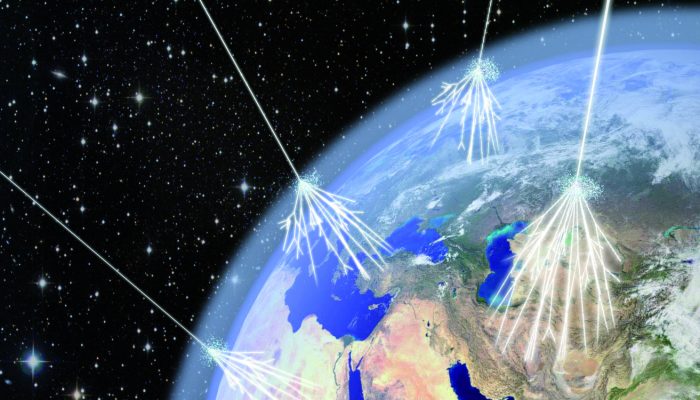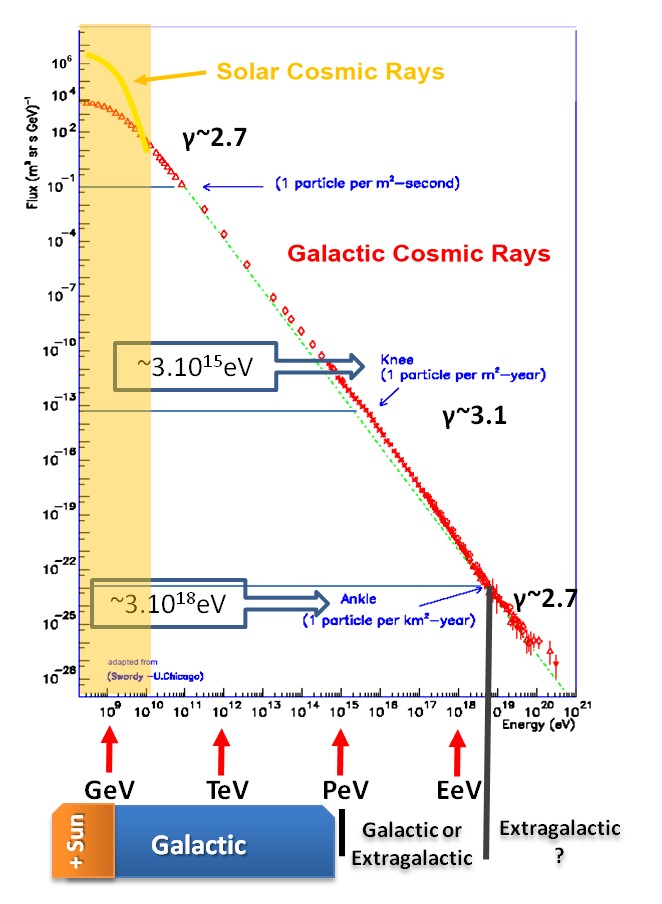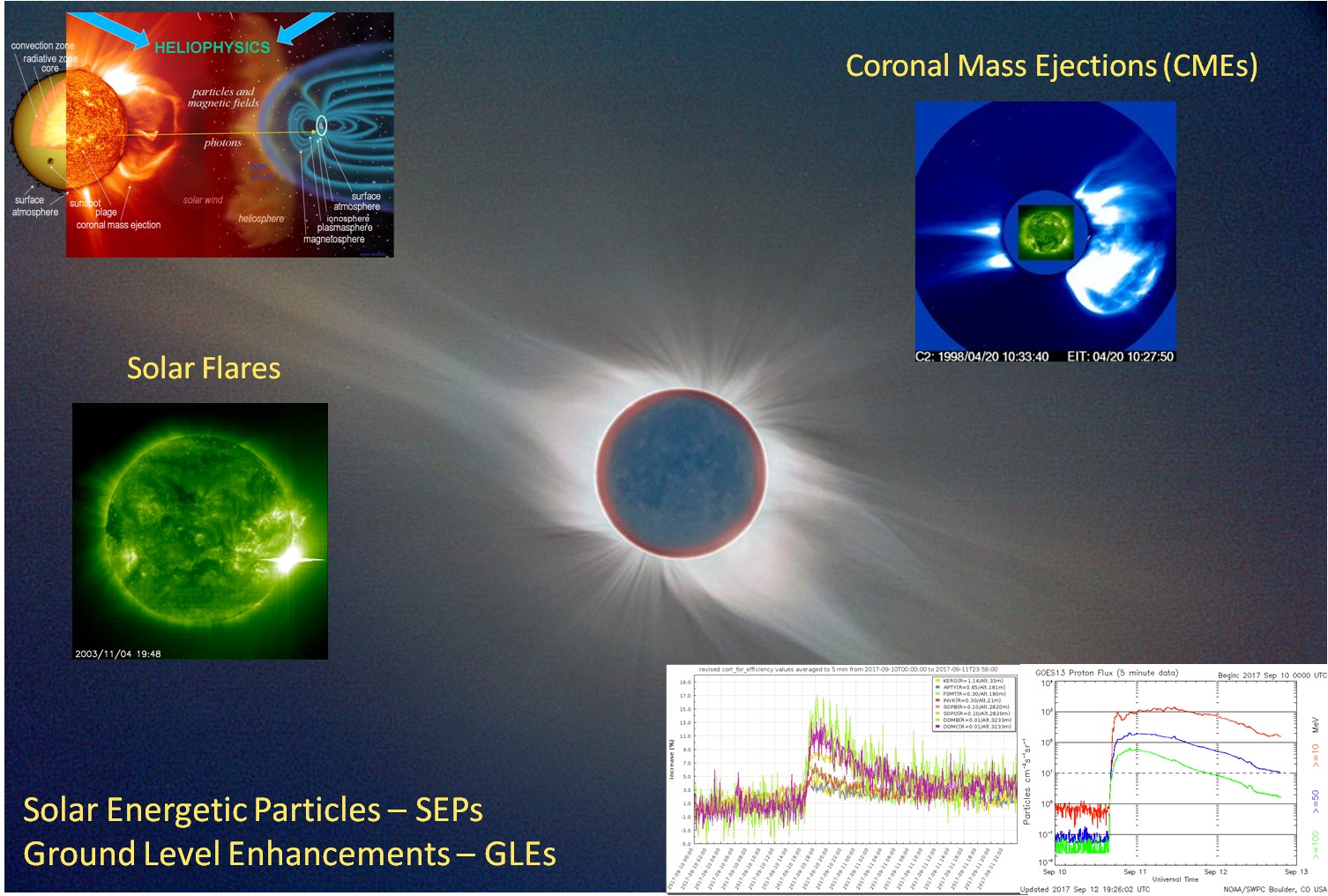
Cosmic rays (CRs), are not actually rays, but highly energetic charged particles of extraterrestrial origin. The life cycle of a cosmic ray particle starts with its birth at some point in the Universe, its travel at nearly the speed of light and finally with its death ( e.g. at a detector). These highly energetic particles strike our planet from all directions and thus provide a constant background. In practice, this means that thousands of cosmic ray particles pass through our bodies every minute, but the resulting radiation imprint is relatively low if we compare this to the natural background radiation.
Sources of CRs, encompass the Sun, our Galaxy and beyond. As a result, these charged particles span almost ~35 orders of magnitude in flux and ~14 orders of magnitude in energy. This, means that we need many different experimental devices (e.g. spacecraft data, neutron monitors, muon telescopes, AMS02, PAMELA, TRACER, IceTop, Pierre Auger Observatory and many more) to capture the entire spectrum of CRs and at the same time this offers many opportunities to evolve our experimental/detection set ups and our understanding. We measure the energy of CRs in eV (electron-Volt: it corresponds to the energy gained when an electron is accelerated through a potential difference of 1 volt). Based on the energy of CRs, we can identify the origin and map different parts in the spectrum. For example, above a few GeV/nucleon, the energy spectrum of CRs follows a power law proportional to E−2.7. At ∼1015 eV there is a break in the spectrum, which is typically referred to as the “knee”, below this energy CRs are of Galactic origin. From the “knee” up to ∼1018 eV the power law falls as E−3.1. A second break in the spectrum occurs at 1018 eV, usually called the “ankle”, where the spectrum flattens. At this energy it is possible that the particles can be of extragalactic origin. The CR spectrum continues up to ∼1020 eV, which is the current high-energy limit for CR observations.

The spectrum of CRs, denoting the different components and sources (Credit: A. Papaioannou, adopted from the CR spectrum by S. Swordy).
Low energy (up to ~1015eV) Galactic CRs (GCRs) are most likely accelerated in supernovae (SN) shock waves which occur approximately once every 50 years in our Galaxy. GCRs are the only matter originating from outside our solar system that can be studied directly. Thereby, their composition and energy spectra can be used to determine their sources, acceleration mechanisms and transport processes in the Galaxy. However, since CRs are charged particles those are deflected by magnetic fields. This, in turn, obscures the identification of their actual source, since their travel paths have been randomized.
At the same time the Sun is an additional sporadic source of energetic particles, often termed as solar CRs (SCRs) and/or Solar Energetic Particles (SEPs). These particles are accelerated by shock waves driven by coronal mass ejections (CMEs) traveling through the corona, and by the magnetic energy that is released in solar flares. When a CME occurs 100 million tons of hot coronal gas is suddenly ejected into space at speeds of 1.6 million km per hour. SFs are observed in white light, UV, soft and hard x-rays, gamma-rays, neutrons and radio waves and hence cover the entire electromagnetic spectrum. When CRs penetrate into our solar system, those are affected by the interplanetary magnetic field (IMF), which is embedded in the solar wind blowing from the Sun. Therefore CRs have difficulty reaching the inner solar system and Earth. Solar activity (and the rate of CMEs and SFs) varies over the 11 year solar cycle, leading to a variation in the intensity of CRs at Earth, in anti-correlation with the solar activity (as represented by the sunspot number). Furthermore, the interplanetary counterparts of propagating CMEs reduce the GCRs flux, leading to a decrease known as the Forbush decrease.

The heliospheric enviroment. Inserts include, an artistic representation of the Sun-Earth relations (Credit: NASA), a solar flare (SoHO/EIT), a coronal mass ejection (SoHO/LASCO), the recent Solar Energetic Particle (SEP) event from 10 September 2017 and the corresponding recordings from spacecraft (GOES) and neutron monitors on the ground (Ground Level Enhancement – GLE; NMDB) (Credit: A. Papaioannou)
If CRs are energetic enough and reach the Earth’s atmosphere, undergo collisions with its atoms and produce a cascade of secondary CR particles that shower down through the atmosphere to the Earth’s surface. These secondary CRs include pions, electrons and positrons. The number of particles that reach the Earth’s surface is related to the energy of the primary CRs that made it to the upper atmosphere. The deeper the particles penetrate into the atmosphere, the more energy they lose. A SF and/or a CME may result to an intense flux of SCRs, which gives ground to an SEP and when recorded on the Earth’s surface, to a Ground Level Enhancement (GLE).
GCRs, being messengers from space, hold a key for the greater understanding of our universe, since the most exciting frontiers of astrophysics involve physical processes and environments that are not reproducible in the laboratory. In addition, CRs carry information from their interaction with the magnetic irregularities they encounter en route to the Earth and help us track our heliospheric environment. They also quantify the radiation levels encountered by air crews on flight altitudes and by astronauts in space.

A synthesis of different figures showing the RAD on MSL on the surface of Mars; RAD’s field-of-view and the corresponding parts of the detector, as well as , the historical photo of Victor Hess in a ballon en route to the discovery of cosmic rays (Credit: A. Papaioannou, using figures from this presentation)
In August 2012, 100 years since the discovery of CRs from Victor Hess, the Radiation Assessment Detector (RAD) onboard the Mars Science Laboratory (MSL) measures for the first time CRs on the surface of another planet.
A thrilling new era has already began !
